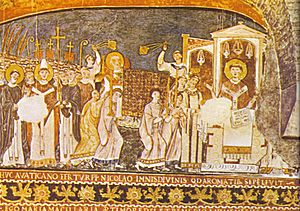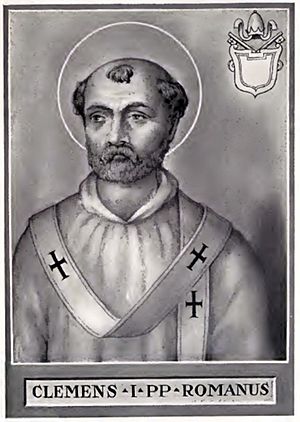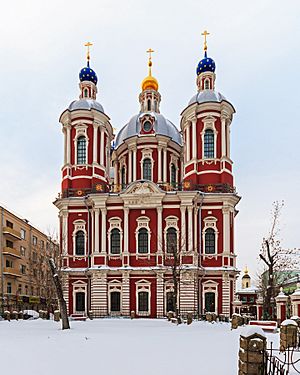Clement of Rome facts for kids
Quick facts for kids Pope Saint Clement I |
|
|---|---|
| Bishop of Rome | |
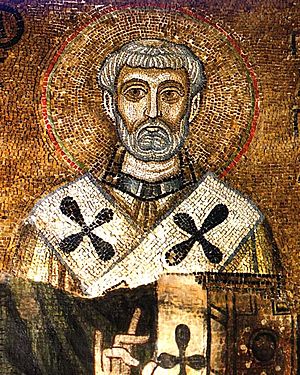
c. 1000 portrayal at Saint Sophia's Cathedral, Kyiv
|
|
| Church | Catholic Church |
| Papacy began | 88 AD |
| Papacy ended | 99 AD |
| Predecessor | Anacletus |
| Successor | Evaristus |
| Orders | |
| Consecration | by Saint Peter |
| Personal details | |
| Born | c. 35 AD Rome, Roman Empire |
| Died | 99 AD (aged 63-64) Chersonesus, Taurica, Bosporan Kingdom |
| Sainthood | |
| Feast day |
|
| Venerated in | |
| Attributes |
|
| Patronage |
|
| Shrines | Basilica di San Clemente, Rome St Clement's Church, Moscow Diocesan Shrine and Parish of St. Clement, Angono, Rizal, Philippines |
| Other Popes named Clement | |
Pope Clement I (also known as Clement of Rome) was an important early leader of the Christian Church. He was the bishop of Rome in the late 1st century AD, from about 88 AD until his death in 99 AD. He is considered one of the first "Apostolic Fathers," meaning he was a Christian leader who lived very close to the time of the original Apostles.
Not much is known for sure about Clement's early life. Some old stories say he was chosen by Peter the Apostle himself. Clement was a key figure in the Christian community in Rome during the late 1st century. Early lists of church leaders place him as the second or third bishop of Rome after Peter. One old book, the Liber Pontificalis, says Clement died in Greece around 101 AD.
Clement is famous for a letter he wrote to the Christian community in Corinth. This letter, called 1 Clement, is one of the oldest Christian writings outside the New Testament. In it, he talked about the importance of church leaders and how they were chosen by the Apostles. This letter helped shape how the early Church was organized.
Contents
Life of Clement
Early records about the leaders of the Church in Rome sometimes list Clement as the first, second, or third successor to Saint Peter. Some historians believe that Peter chose Clement to lead the Church after him. Other lists place Linus and Anacletus before Clement. This shows that the early Church was still figuring out how to keep track of its leaders.
Some old writings from the 3rd and 4th centuries suggest that Clement might be the same Clement mentioned by Paul in the Bible (Philippians 4:3). In this verse, Paul talks about a "fellow worker" named Clement.
A large group of Christians lived in Rome around 58 AD. Both Paul and Peter were said to have been martyred there. Christians in Rome faced tough times, especially under Emperor Nero and later Domitian. Clement became one of the most important early bishops of Rome. The Liber Pontificalis, a book that records the lives of popes, says that Clement knew Peter personally.
Clement's letter to the church in Corinth, written around 96 AD, is very important. In this letter, he explained that church leaders, called episkopoi (overseers or bishops) and presbyteroi (elders or priests), had authority because the Apostles had appointed them. This letter helps us understand how the early Church was organized and led.
Death and Legends
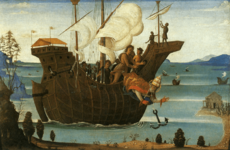
According to old stories from the 4th century, Clement was sent away from Rome by Emperor Trajan to work in a stone quarry. When he arrived, he saw that the prisoners had no water. Clement prayed, and a lamb appeared on a hill. He went to the spot where the lamb stood, struck the ground with his pickaxe, and clear water gushed out! This miracle led many local people and prisoners to become Christians.
Because of this, Clement was punished. He was tied to an anchor and thrown into the Black Sea to drown. This is why he is often shown with an anchor. The legend says that every year, the sea would miraculously pull back, showing a special shrine built by God that held his bones.
The Inkerman Cave Monastery in Crimea is believed to be the place where Clement was buried. Years later, in 869 AD, Saint Cyril found what he believed were Clement's bones in Crimea, buried with an anchor on dry land. He brought these relics to Rome, where they are now kept in the Basilica di San Clemente. Other traditions say his head was taken to Kyiv.
Writings of Clement
The Liber Pontificalis says that Clement wrote two letters, but today, only one is definitely known to be his.
First Letter of Clement
Clement's most famous and accepted writing is his letter to the Christian community in Corinth, often called 1 Clement. This letter is considered the oldest true Christian document outside of the New Testament.
Clement wrote to the church in Corinth because there was a problem: some church leaders had been removed from their positions. Clement asked the community to make things right and bring those leaders back. He stressed the importance of order and obeying church authority, reminding them that the Apostles had set up the roles of "bishops and deacons." This letter gives us a great look into how the Church was run back then and the history of the Roman Church. It was so important that it was read in churches in Corinth along with the Scriptures around 170 AD.
In his letter, Clement also mentions historical events, like the persecution of Christians and the martyrdom of Saint Peter. He also suggests that Paul traveled to Spain.
Clement's Beliefs
Clement's letter talks about important Christian beliefs. He wrote that "we are not justified by ourselves but by faith," meaning that our goodness comes from faith in God. However, he also stressed that good deeds are important. Clement's letter also mentions the Holy Trinity (God the Father, God the Son, and God the Holy Spirit) and often calls Jesus the High Priest.
Writings Once Thought to Be By Clement
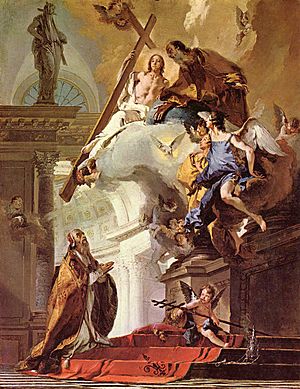
Some other writings were once believed to be by Clement, but most experts today agree he didn't write them.
Second Letter of Clement
The Second Epistle of Clement is actually a sermon, not a letter, and it was probably written by someone else in the 2nd century. Early Christian groups often shared sermons to be read in church, and this one might have been sent along with Clement's real letter, leading people to think he wrote it.
Other Writings
Two other "Epistles on Virginity" were also once thought to be Clement's, but almost everyone now agrees he was not their author.
False Decretals
In the 9th century, a collection of church laws called the "False Decretals" appeared. Many of these documents, including some supposedly from early popes like Clement, were actually forgeries (fake documents). These fake writings tried to make it seem like early popes had more power and authority than they really did.
Clementine Literature
Clement is also the main character in some old Christian stories, almost like novels, called the "Clementine literature." In these stories, he is shown as the person through whom the Apostles shared their teachings with the Church.
Saint Clement
Clement's name is included in the Roman Canon of the Mass, which is a central part of Catholic worship. He is honored as a pope and martyr on November 23 in the Catholic Church, the Anglican Communion, and the Lutheran Church. Many Eastern Orthodox Churches celebrate his feast day on November 24 or 25.
The St Clement's Church in Moscow is famous for its beautiful interior. It was closed for many years during the Soviet era but was returned to the Russian Orthodox Church in 2008.
The Coptic Orthodox Church also remembers Clement on November 25 (which is December 8 on our modern calendar). They believe he was martyred in 100 AD by being tied to an anchor and thrown into the sea.
Relics of Clement
Besides the relics in Rome and Kyiv, a shinbone believed to be Clement's is kept in the city of Santa Cruz de Tenerife in Spain. This relic was given to the Church of the Immaculate Conception and was highly respected in the city.
Symbols of Saint Clement
In art, you can often recognize Saint Clement by an anchor next to him or tied around his neck, which refers to how he died. He is usually shown wearing papal vestments (special clothes for a pope), sometimes with a papal tiara or a mitre (a tall hat worn by bishops). He might also hold papal symbols like the papal cross or the Keys of Heaven. Because he was a martyr, he often holds the palm of martyrdom.
Sometimes, Clement is shown near a fountain or spring, remembering the miracle he performed in the quarry. The Anchored Cross is also known as St. Clement's Cross because of his martyrdom.
See also
 In Spanish: Clemente de Roma para niños
In Spanish: Clemente de Roma para niños
- List of popes
- List of Catholic saints
- Pope Saint Clement I, patron saint archive
- St Clement's Day


